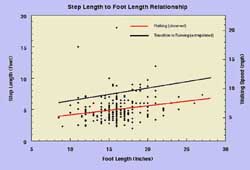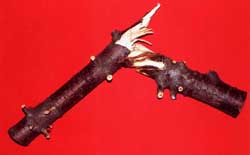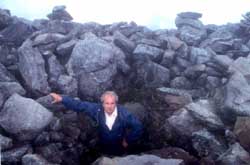|
|

|

FAQ Home > What is a Bigfoot, or Sasquatch?
Behavior |  Most sasquatches are observed walking, and the observer almost invariably comments on their smooth, long and fluent stride ("like cross country skiing" or "like riding a bicycle") with wide arm swings. This effect is produced by their so-called compliant gait, meaning that they do not lock their knees during a step but keep them bent and thereby suppress the up-and-down oscillations of the upper body that is so characteristic of the human gait. Part of the sasquatch gait is a high foot rise in back during the swing phase and a longer bipedal contact with the ground. Step length averages 5’ (Fig. 14), an interval that is uncomfortable or impossible to duplicate or sustain for any distance by a would-be hoaxer. The gait has very little straddle, i.e., feet are put in line. Most sasquatches are observed walking, and the observer almost invariably comments on their smooth, long and fluent stride ("like cross country skiing" or "like riding a bicycle") with wide arm swings. This effect is produced by their so-called compliant gait, meaning that they do not lock their knees during a step but keep them bent and thereby suppress the up-and-down oscillations of the upper body that is so characteristic of the human gait. Part of the sasquatch gait is a high foot rise in back during the swing phase and a longer bipedal contact with the ground. Step length averages 5’ (Fig. 14), an interval that is uncomfortable or impossible to duplicate or sustain for any distance by a would-be hoaxer. The gait has very little straddle, i.e., feet are put in line.
Running sasquatches constitute about 10% of all sightings. From observed walking cadence, step length and reports of animals running alongside moving vehicles, their top speed probably rivals that of a running horse (near 40 mph). The step length (measured from heel to heel) changes little whether the animal walks on the level or uphill. When standing still, the sasquatch will often remain totally immovable to escape detection, or at best slowly sway from side to side. They have been seen to assume the same sitting, squatting or lying positions that people do, frequently shown by worn areas on their hair coat. Quadrupedal gait is seen rarely in juveniles, although adults, on ascending dense slopes, frequently pull themselves up on adjacent trees with alternating arms.
In contrast to other higher primates, they seem to be powerful swimmers, as seen by their sporadic presence on otherwise uninhabitable small islands of the British Columbia coast and direct observations of animals in or under water, doing a frog-kick.
 They sleep in mostly temporary shelters, padded with available vegetation. Caves and natural shelters seem to be used rarely. Padding consists of ferns, moss, bear grass, soft evergreen or rhododendron branches and leaves. Occasionally partial roofs are fashioned over their resting places from broken boughs. Once discovered, a nest is generally abandoned. They sleep in mostly temporary shelters, padded with available vegetation. Caves and natural shelters seem to be used rarely. Padding consists of ferns, moss, bear grass, soft evergreen or rhododendron branches and leaves. Occasionally partial roofs are fashioned over their resting places from broken boughs. Once discovered, a nest is generally abandoned.
Their strength, especially upper body, is legendary. They seem to take "pleasure" in exercising this strength, for example, lifting basketball-sized rocks and throwing them in arcs to scare off intruders, lifting the edges of mobile homes, cars or trailers, lifting and throwing full 50 gal. drums (450 lbs.) or 240 lb rocks (weighed later), and spirally twisting the trunks of small trees, possibly as territorial or way markers (Fig. 15).
Vocalization and Communication
On the whole, the sasquatch proceeds in silence. Patterned, repetitive knocking sounds, produced with rocks or thick branches hit against other rocks or dead trees, are apparently used as long distance communication or deterrence.
Since they are a nocturnal species, they seem to rely on vocalizations more than diurnal primates. They are capable of a complex collection of sounds, starting with whistling (produced in the throat), through moans, howls, hoots, grunts, extremely deep growls, roars ("like a lion from the bottom of a 50-gallon drum"), and chilling screams, rising from a low roar over several seconds. More rarely, they produce melodic and imitative sounds or complex vocalizations that give the impression of a primitive language, even of a "woman talking" without the "words" ever being intelligible.
The disturbing nature of the loud screams seems to lie in their perceived near human quality, though too loud, enduring and powerful to be attributed to any possible "real" person. Giggling, laughing and crying sounds have been heard, sometimes in response to appropriate events.
There has been little opportunity to study facial expressions of the sasquatch, which are apt to be different from human ones and might be misinterpreted. But very close observers reported a comical look of surprise, when a sasquatch was suddenly encountered at close range, evident curiosity, as well as a look of "sheer terror" of a sasquatch caught between traffic on a dark, rainy highway.
Social Behavior and Curiosity
Despite the rare observations of sasquatch groups, they appear to have more social cohesion than is generally assumed, moving at times in a group that suggests an extended family. Under undisturbed circumstances, the young play with each other and around and on the adults, and sometimes small groups forage together. Young ones are allowed to explore and be potentially visible in a context where the adults stay out of view. Adults seem remarkably indulgent of the infants, tolerating on one occasion an infant’s temper tantrum without intervention. In a totally relaxed setting, the adults spend substantial time grooming each other. On a few occasions, two or more sasquatches were observed wrestling with each other with intermissions for rest. It appears that older siblings, or at least juvenile animals, sometimes care for younger ones. The need for large amounts of food for any one animal may lead to a fusion - fission type of social organization, in which individuals separate to forage and come together for social activities.
The more frequent sightings of single males over females may be due to these animals probing the terrain for new niches, food sources or mates. They most probably form the majority of cases in which curiosity lures an animal into plain sight. Such curiosity-evoking events range from a lighted window in a secluded house to barns with animals in them, unusual animals in outside corrals, cars or equipment being repaired in a remote location, loud noises like chainsaws or explosions, and especially the screaming of children at play. Repeatedly, sasquatches have watched in these contexts, occasionally for hours, and even attempted interaction in the play of children. Sometimes, a sasquatch seen in the open, will retreat into cover, but remain to watch his observers from (incomplete) hiding.
 Two noteworthy facets of sasquatch behavior have been observed repeatedly. They seem to be rather "orderly", stacking rocks in cairns during searching (Fig. 16) and not tearing human food caches or backpacks apart randomly in the manner of bears. Secondly, they have a tendency to leave "gifts" in the same location in which food was deposited for them. These can range from little piles of stones, a dog skull, handfuls of evergreen shoots, to small live animals, like a goat kid, several live kittens, a turtle, all taken from elsewhere, either as a "gift" or possibly as shared "food". Two noteworthy facets of sasquatch behavior have been observed repeatedly. They seem to be rather "orderly", stacking rocks in cairns during searching (Fig. 16) and not tearing human food caches or backpacks apart randomly in the manner of bears. Secondly, they have a tendency to leave "gifts" in the same location in which food was deposited for them. These can range from little piles of stones, a dog skull, handfuls of evergreen shoots, to small live animals, like a goat kid, several live kittens, a turtle, all taken from elsewhere, either as a "gift" or possibly as shared "food".
Aggressiveness and Displays
Their responses to people vary from immediate withdrawal, the most common response, to lengthy inspection if no threat is perceived. They seem to react in a more relaxed fashion to women and children and avoid men, even in an accustomed setting, possibly as a function of human body language. All told, they are unaggressive to a fault, often leisurely retreating while being shot at. There is no documented case in the past 100 years of a sasquatch doing deliberate harm to a person.
Sasquatches seem to be indulgent of human children and small animals, like puppies, goat kids, and kittens. Several reports suggest that they may opportunistically retain small animals to use as live toys or pets as has been observed in bonobos. On the other hand, they reserve a special distaste for aggressive dogs, as do gorillas. They deal with these by slapping them (causing a 75 lb. dog to fly 40’) or flailing them against trees.
While scaring people out of their territory, they often run alongside them, though out of sight, and only desist when the terrain would expose them to view. This effort is sometimes preceded or accompanied by tree shaking, pushing over of trees or snags with appropriate noise, or simply by repeatedly breaking large sticks or branches for the sound effect. The apparent sounds of chest thumping have been heard, but the behavior has not been seen. All these aggressive displays are also found in the great apes.
It would be ideal for a human observer, in an unanticipated encounter, not to stare at the animal, but to sit on the ground, scratch him or herself, "groom" a companion, or "eat" anything within reach in order to convey as benign an impression as possible. In one instance, in which this behavior was followed, the sasquatch tarried long enough to be "talked" to.
Tool Use
This trait of the human species is largely absent in the sasquatch. As mentioned above, they use branches and rocks to hit trees or other rocks and they throw rocks and other objects out of hiding to scare people out of their territory (as do chimpanzees). Only one case has come to my attention of a boy being inadvertently hit by such a thrown rock (though not seriously injured). Rare reports indicate the possibility of the sasquatch using sticks to kill birds or mammals or to dig in the ground with them.
On one occasion they were observed to fashion "straws" out of the stalks of dead weeds and to drink through them out of a metal tub. They are undoubtedly observant of human appurtenances, such as guns or obvious cameras, and may then take extra care to avoid exposure.
Injury, Disease and Death
Aside from eventual death after getting shot at or getting injured on highways, sasquatches probably die from dental disorders, infections, parasitic infestations and the rigors of exposure to the elements. From their prey, they would become parasitized with every type of intestinal worm as well as flukes. The absence of corpses is expected in the montane environment they inhabit, and it can profitably be compared to a similar absence of bears that died of natural causes. There are some minimal suggestions that sasquatches do not leave their dead unattended, a further factor that would confound such searches for a body.
Ecology
The sasquatch is distributed across the North American continent, from high northern latitudes in Alaska and the Yukon to occasional sightings near river courses and forests in New Mexico and Texas. Their highest concentration appears to lie in Washington, Oregon and northern California, although the chances of potentially more sightings in the wilds of Canada are lessened by the lower human population density. Total numbers for the species in North America have been estimated by various approaches to be from a few thousand up to 10,000. By comparison, black bears number between 650,000 and 700,000 in North America.
Distribution of the sasquatch is presumably heavily influenced by the availability of water, prey, and of dense cover as afforded by northwestern rain forests, Sierra chaparral or the riparian margins of any bodies or courses of water. Since the latter provide secluded avenues throughout the continent, occasional sightings are explicable in relatively arid regions, though even there generally in the vicinity of stands of forest. Similarly, swamps and marshes seem to afford them the desired seclusion. Migration patterns, if they exist at all, have not been established other than possible vertical movement to escape severe winter conditions at higher altitude.
Sightings largely parallel the density of the human population, within reasonable limits. Daytime and nighttime sightings are almost equal in number despite the severely limited sight distance and coverage for observers at night, an indication of the much greater nocturnal activity of the sasquatch. Most sightings consist of chance encounters with single individuals, mostly males by default (identification made difficult by the hairiness of the species). It appears that the animals can be to a considerable degree habituated to the presence of a person. They are more likely to become "tamer" with a woman, over a long period, provided they are fed and not bothered, such as being illuminated at night. Under such long established circumstances, they allow themselves to be seen during their normal activities, even during daylight hours, but mostly at dawn. They are reported substantially less frequently during the late winter, but outright hibernation is not known to occur in primates, though torpor is a possibility. It is probable that in the winter the animals adopt a retiring life style with little activity in some protected niche, surviving on predation and some available vegetation.
Sasquatches of the size mentioned in this article would be expected to roam over a substantial territory to support themselves, possibly hundreds of square miles. Twisting off of small trees, nocturnal screaming and defecation in conspicuous spots have been suggested as possible territorial devices, all of these known from other great apes. In the predominantly forested terrain that they inhabit, footprints are seen with difficulty at best, and it would, at first sight, seem unlikely that they deliberately post or hide them.
Evolution
Evolutionary discussion at this stage would consist of rather futile conjecture when a single good DNA analysis of a piece of skin or well-preserved blood could narrow the choices dramatically. The species is deviant from Homo sapiens by anatomy (crest, feet, musculature, body posture and gait), behavior (nocturnality, lack of compelling tool use, lack of language, lack of cultural traits) and sociology, traits that all argue against a close relationship to modern man. Its potential competitiveness for the same natural resources and space as that used by man may well have been contributory to the evolution of their nocturnal and elusive life style. The paleontological affiliation or identity with Gigantopithecus, as championed by the late Grover Krantz, has many aspects to recommend it. | | Previous: Physiology | | Next: Useful Literature |
| |
|
|






















